Wyoming
State
Parks & Historic Sites
GUERNSEY
MUSEUM DIGITIZATION PROJECT
Guernsey
State Park is one of the most significant Depression Era 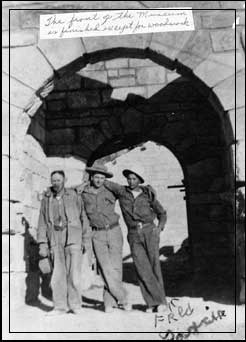 parks in the nation. Guernsey was the first cooperative venture between
the Bureau of Reclamation, the National Park Service and the Civilian
Conservation Corp to develop a public recreation area. Based on the
success of this agreement Guernsey became a prototype for developing
recreational facilities at Bureau of Reclamation reservoirs. This
would eventually lead to some of the most massive and popular facilities
in the National Park Service. For this and several other reasons Guernsey
State Park has been designated a National Historic Landmark.
parks in the nation. Guernsey was the first cooperative venture between
the Bureau of Reclamation, the National Park Service and the Civilian
Conservation Corp to develop a public recreation area. Based on the
success of this agreement Guernsey became a prototype for developing
recreational facilities at Bureau of Reclamation reservoirs. This
would eventually lead to some of the most massive and popular facilities
in the National Park Service. For this and several other reasons Guernsey
State Park has been designated a National Historic Landmark.
Following
the stock market crash of 1929 and the subsequent Great Depression
of the 1930s, Franklin Delano Roosevelt was elected president in 1932.
One of Roosevelt's first acts as president was passage of the New
Deal legislation. This entailed a series of government programs and
projects to put the American public back to work and return prosperity
to our 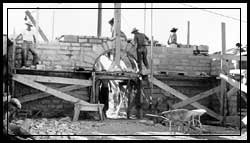 country.
One of the New Deal programs was the Civilian Conservation Corp (CCC).
The CCCs were primarily out of work young men, between the ages of
17 and 25, that were hired by the federal government to work on public
projects. Guernsey is one of the first places where the CCC workers
were allowed to perform skilled labor. Until this time, CCC workers
were viewed as general laborers suitable for forestry and soil conservation
activities. As a result, most of the CCC companies worked for the
United States Forest Service and were often referred to as Roosevelt's
Tree Army. However, at Guernsey State Park the CCC proved that with
sufficient training and supervision they were capable of constructing
high quality and enduring examples of architecture.
country.
One of the New Deal programs was the Civilian Conservation Corp (CCC).
The CCCs were primarily out of work young men, between the ages of
17 and 25, that were hired by the federal government to work on public
projects. Guernsey is one of the first places where the CCC workers
were allowed to perform skilled labor. Until this time, CCC workers
were viewed as general laborers suitable for forestry and soil conservation
activities. As a result, most of the CCC companies worked for the
United States Forest Service and were often referred to as Roosevelt's
Tree Army. However, at Guernsey State Park the CCC proved that with
sufficient training and supervision they were capable of constructing
high quality and enduring examples of architecture.
Guernsey
State Park is where some of the most important National Park Service
park planners of the Depression Era honed their trade, people like
Conrad Wirth and Thomas Vint. These men were responsible for the "Rustic"
architectural movement. The basis of Rustic architecture was simplicity
in design, use of native building materials, avoidance of overly prefect
construction lines, and a general feeling of having been built by
pioneer craftsmen. While these buildings may sometimes appear crudely
built, they are often excellent examples of design and craftsmanship.
The 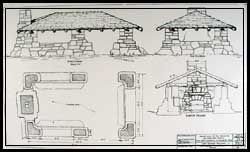 Sitting Bull picnic shelter is a superb example of Rustic architecture,
it is difficult to tell where the ground stops and this building begins
as it rises out of the rock landscape. Some of our country's best
examples of Rustic architecture are at Guernsey State Park. When you
are in the park look for examples of how the buildings are blended
into the surrounding landscape.
Sitting Bull picnic shelter is a superb example of Rustic architecture,
it is difficult to tell where the ground stops and this building begins
as it rises out of the rock landscape. Some of our country's best
examples of Rustic architecture are at Guernsey State Park. When you
are in the park look for examples of how the buildings are blended
into the surrounding landscape.
Guernsey
State Park is unusual because of the historic integrity of the CCC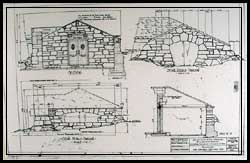 buildings and features within the park. The historic portions of the
park have been left unmodified since they were constructed in the
1930s. No where is this more evident then at the park museum. The
museum building and displays are essentially intact to 1937. Today,
the Guernsey State Park museum represents the finest and most intact
example of a 1930s trail side state park museum
buildings and features within the park. The historic portions of the
park have been left unmodified since they were constructed in the
1930s. No where is this more evident then at the park museum. The
museum building and displays are essentially intact to 1937. Today,
the Guernsey State Park museum represents the finest and most intact
example of a 1930s trail side state park museum
The
floor of the museum building was quarried, assembled and numbered
in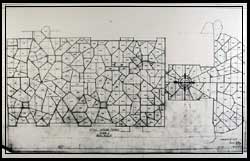 Thermopolis, Wyoming. The floor was then disassembled, shipped
to the Guernsey State Park museum and reassembled. If you look closely
you can still see some of the numbers on the museum floor.
Thermopolis, Wyoming. The floor was then disassembled, shipped
to the Guernsey State Park museum and reassembled. If you look closely
you can still see some of the numbers on the museum floor.
In
1934, two of the nine CCC companies assigned to the Bureau of Reclamation
were stationed at Guernsey State Park. Company 844 was 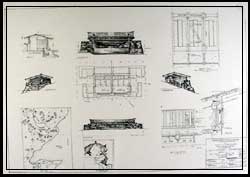 located at Camp BR-9 on the east side of the reservoir and Company
1855 was located at Camp BR-10 on the west side of the reservoir.
Each camp was responsible for the construction of facilities on their
respective side of the reservoir. This was done intentionally to foster
competition between the CCC companies. In the spirit of competition
even ordinary structures, such as latrines, could became elaborate
facilities and a source of pride for the workers.
located at Camp BR-9 on the east side of the reservoir and Company
1855 was located at Camp BR-10 on the west side of the reservoir.
Each camp was responsible for the construction of facilities on their
respective side of the reservoir. This was done intentionally to foster
competition between the CCC companies. In the spirit of competition
even ordinary structures, such as latrines, could became elaborate
facilities and a source of pride for the workers.
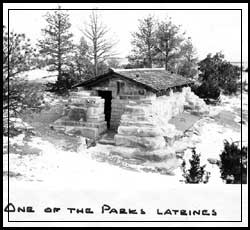
The
Million Dollar Biffy was probably the finest latrine of its time.
The latrine cost over $6,000 to construct, but was purported to be
worth a million dollars; hence, the name "Million Dollar Biffy."
Today it would be very difficult to match the materials and workmanship
in this structure.
Guernsey
is one of the first examples of treating a park as an interconnected
landscape, instead of a series of isolated locations. Public activity
was 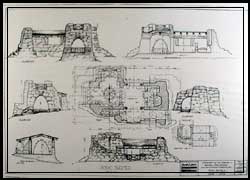 planned to be centered around certain attractions, most notably
the lake and the high overlooks. The first thing developed was the
transportation network; Lake Shore Drive to provide access to the
reservoir and Sky Line Drive to take advantage of the vistas. An extensive
network of pedestrian trails and horse trails were also developed,
this allowed for the separation of motor vehicles, horse traffic and
pedestrians. All three provide a complete circulation system in the
park, connecting hill tops, park facilities, overlooks, and natural
settings.
planned to be centered around certain attractions, most notably
the lake and the high overlooks. The first thing developed was the
transportation network; Lake Shore Drive to provide access to the
reservoir and Sky Line Drive to take advantage of the vistas. An extensive
network of pedestrian trails and horse trails were also developed,
this allowed for the separation of motor vehicles, horse traffic and
pedestrians. All three provide a complete circulation system in the
park, connecting hill tops, park facilities, overlooks, and natural
settings.
To
provide a variety of outdoor experiences the park was divided into
a A conservation area and a recreation area. In other words, formal
recreational developments are on the east side of the park leaving
the west end undeveloped. The Castle is on the dividing line between
the conservation area and the recreation area.
The
Castle may be the most elaborate picnic shelter in the country. Along
with producing grand structures, Rustic architecture often tried to
tie the 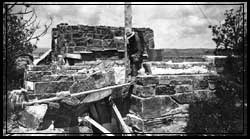 landscape to the building. There are two arched walkways on the
lower level of the Castle, if you line up the two archways they point
directly to Laramie Peak, the highest peak in the surrounding region.
landscape to the building. There are two arched walkways on the
lower level of the Castle, if you line up the two archways they point
directly to Laramie Peak, the highest peak in the surrounding region.
Guernsey
State Park is truly a national gem, when you have an opportunity visit
this site and learn more about Rustic architecture and the Civilian
Conservation Corp.